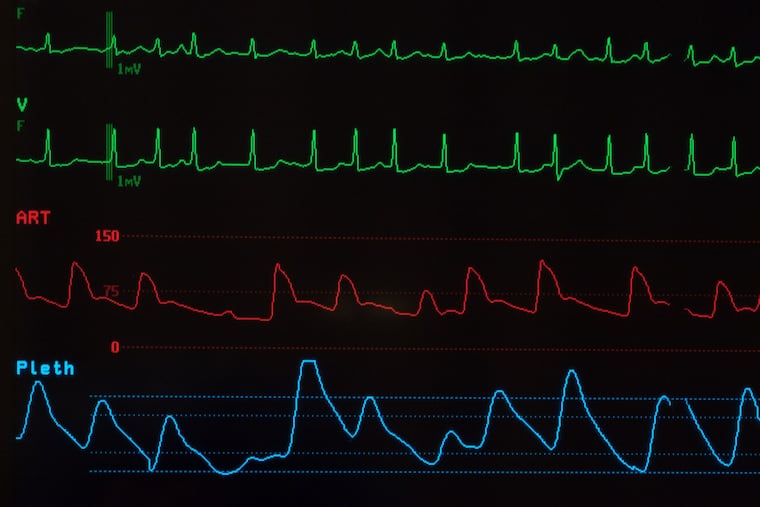Watchman cardiac device: Another side of the story
Yes, there are caveats to consider regarding the new Watchman device for atrial fibrillation. But not as many as a recent Inquirer column suggests, writes a local cardiologist

I read with interest the July 4 Inquirer article, “Watchman cardiology device is expensive and heavily marketed. How many patients really need it?”
Like the writer, cardiologist David Becker, I care for many patients with atrial fibrillation, who as a group are at risk for clot formation in the left atrial appendage of the heart, and subsequent potentially devastating stroke or damage to other organs. Blood thinners help dissolve these clots before they “embolize” from the heart. But the major risk of anticoagulation is life-threatening hemorrhage.
In 2016, after years of product development and human clinical trials, followed by U.S. Food and Drug Administration (FDA) scrutiny, Boston Scientific Corp. released a ground-breaking device: the Watchman left atrial appendage occluder. The Watchman is inserted through a vein at the top of the leg, advanced to the heart, through the atrial septum, and into the appendage. The procedure is done under general anesthesia and takes about an hour.
The FDA and Centers for Medicare and Medicaid Services published guidelines for use of this device. Becker’s 72-year-old patient with intestinal bleeding, for whom blood thinners would carry ongoing risk of hemorrhage, is a typical Watchman candidate. We know from numerous clinical trials that without blood thinners or the Watchman device, such a patient’s stroke risk is definitely higher.
Becker is a friend and a colleague, and while I wholeheartedly agree with some of his comments, on others our opinions diverge. He is correct that use of Watchman technology is expensive. Each Watchman device is costly, and the resources utilized to implant one (specialized X-ray and ultrasound equipment, multiple personnel including anesthesiologists, cardiologists, nurses, and technologists) are immense. But the alternative is also costly: Untreated patients who suffer strokes place a huge burden on our health-care system. And the costs of anticoagulation are also high: Blood thinners can be expensive, and bleeding complications of oral anticoagulation are also costly, both in terms of dollars and human lives. The point is, there’s no inexpensive way to take care of patients with atrial fibrillation.
I also agree that, like other cardiac procedures, the Watchman procedure is not risk-free. Bleeding, infection, or injury to the heart or blood vessels may occur with these procedures. But intelligent patient selection, careful procedural technique, and greater experience lead to better outcomes. While Becker expresses concern about “spiraling use” of Watchman for “questionable indications,” such things should not occur when this device is in the hands of responsible physicians.
Becker is correct that patients who receive Watchman are advised to take blood thinners for some period of time after the implant; this allows healthy tissue to cover the device so clots don’t form on the device. But the duration is relatively short. In addition, recent clinical trials suggest that simpler blood thinner regimens following Watchman implantation are on the horizon. Regardless, it is clear that compared with those treated with lifelong blood thinners, patients treated with Watchman experience less bleeding in the long run, and they may survive longer.
Becker takes aim at the validity of industry-sponsored studies, such as those that led to approval of Watchman. The public should recognize, however, that virtually all pharmaceuticals or devices on the market have gained approval as a result of industry sponsored trials. That’s unavoidable; public funding is simply not enough. More important, clinical trials data are scrutinized at multiple levels, by teams of independent physicians who carefully analyze the outcomes of the enrolled subjects, and also by FDA advisory committees.
As time passes, technological innovation leads to advances in product performance; we have seen this occurring speedily with transcatheter valve replacement technologies. In addition, increased physician experience and modifications in procedural technique translate to improved outcomes. The results we are seeing with Watchman in 2019 far surpass the outcomes the investigators were observing during the early days of trial enrollment. Lastly, post-marketing surveillance studies create an opportunity for the medical community and the FDA to rigorously analyze the performance of devices and pharmaceuticals after they are released to market.
So how might we responsibly utilize the Watchman technology for our patients? First, we must formulate an in-depth understanding of the Watchman clinical trials data set in order to counsel our patients and educate our peers. Second, we must carefully select patients for this procedure based on strict clinical and anatomic criteria. This is best done by assembling a “heart team” of various cardiovascular sub-specialists. In doing so, a high success rate with a low complication rate can be reliably achieved.
Bruce Klugherz is a cardiologist and director of the Abington Hospital catheterization lab.